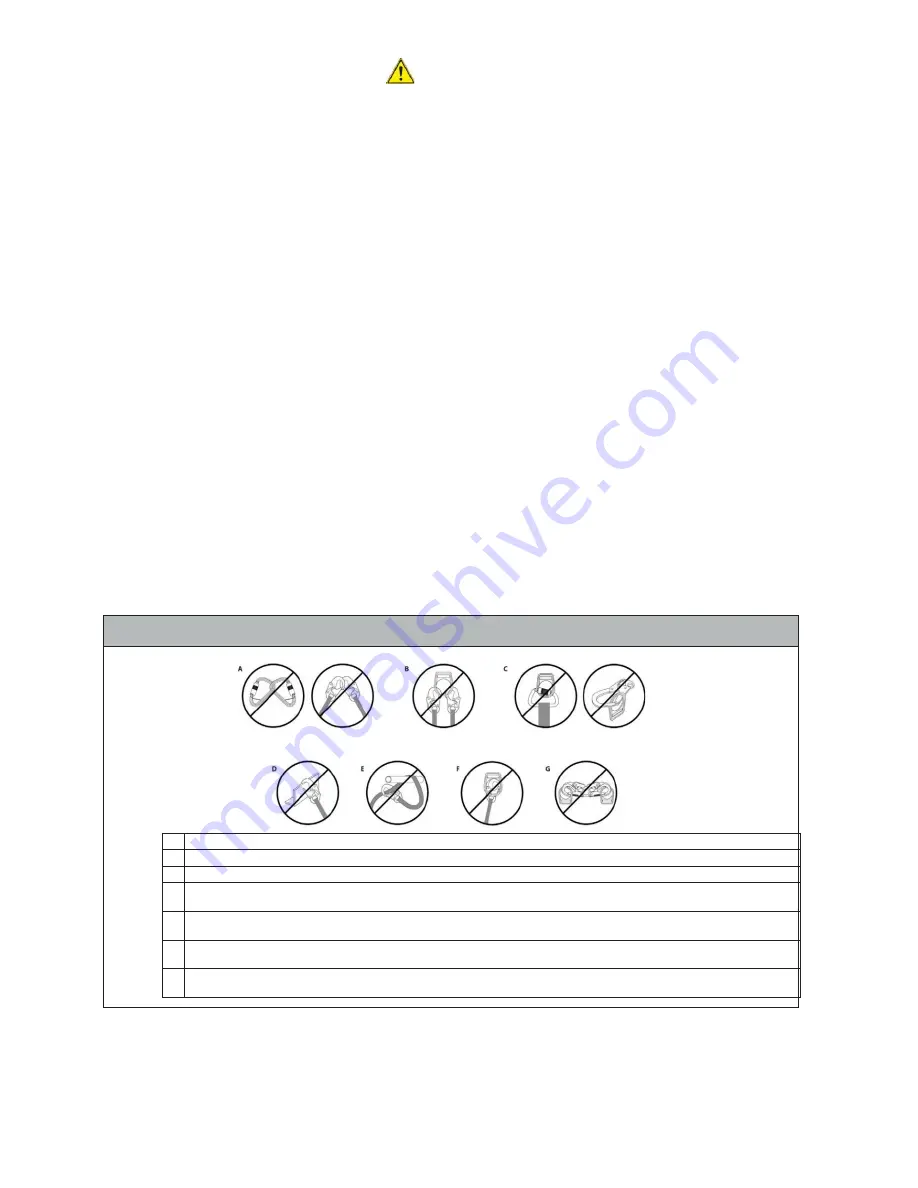
Figure 6 - Incorrect Connections
WARNING
When a worker falls while connected to the horizontal lifeline, the system will deflect. If two or more workers are connected to
the same horizontal lifeline, and one worker falls, the other workers may be pulled off the walking-working surface. The
potential for the other workers falling increases as the lifeline length increases. The use of independent HLL systems for each
person or shorter span lengths or intermediate anchor points is recommended to minimize the potential of the other workers
falling.
2.8 Rescue:
The
PALMER SAFETY
2-Person Temporary HLL is part of a complete PFAS. It is not intended as a rescue device.
Use of this system presents a wide variety of potential rescue scenarios. Users of this system should understand their
work environment and develop a rescue plan accordingly. It is recommended that a trained on-site rescue team be
present during use of the system.
3.0
System Requirements
3.1
Anchorage Strength:
End anchors selected for use with this system must have a minimum rating of 5,000 lbs. (22.2 kN) for one- and two-
worker applications.
3.2
Structure:
The mounting points for the anchorage must be capable of supporting no less than 5,000 lbs. (22.2 kN) for one- and two-
worker applications, see Figure 7.
3.2
Compatibility of Connectors:
Connectors are considered to be compatible with connecting elements when they have been designed to
work together in such a way that their sizes and shapes do not cause their gate mechanisms to inadvertently open regardless of how
they become oriented. Contact PALMER SAFETY if you have any questions about compatibility. Connectors must be compatible with
the anchorage or other system components. Do not use equipment that is not compatible. Non-compatible connectors may
unintentionally disengage. Connectors must be compatible in size, shape, and strength. Self-closing, self-locking snap hooks and
carabiners are specified by OSHA and ANSI Z359.12.
3.3
Compatibility of Components:
Equipment is designed for use with approved components and subsystems only. Substitutions or
replacements made with non-ANSI Z359 compliant components or subsystems may jeopardize compatibility of equipment and may affect
the safety and reliability of the complete system. Ensure compatibility between the connectors if non- PALMER SAFETY components are
used for fall protection, see Figure 6.
3.4
Connectors:
Only use self-locking snap hooks, rebar hooks, and carabiners with this equipment. Only use connectors that are suitable to
each application. Ensure all connections are compatible in size, shape and strength. Do not use equipment that is not compatible. Visually
ensure all connectors close and lock completely. Connectors (snap hooks, rebar hooks, and carabiners) are designed for use only
as specified in this manual.
A
Never connect two active components (snap hooks or carabiners) to each other.
B
Never connect two active components (snap hooks or carabiners) to a single D -ring at the same time.
C
Never connect in a way that would produce a condition of loading on the gate.
D
Never attach to a object in a manner whereby the gate (of the snap hook or carabiner) would be
prevented from fully closing and locking. Always guard against false connections by visually inspecting for closure and lock.
E
Never attach explicitly to a constituent subcomponent (webbing, cable or rope) unless specifically provided for by the
manufacturer’s
instructions for
both subcomponents (snap hook or carabiner and webbing, cable or rope).
F
Never attach in a manner where an element of the connector (gate or release lever) may become caught on the anchor thereby producing
additional risk of false engagement.
G
Never attach a spreader snap hook to two side/positioning D-rings in a manner whereby the D-rings will engage the gates; the gates on a spreader
must always be facing away from the D-rings during work positioning.






























